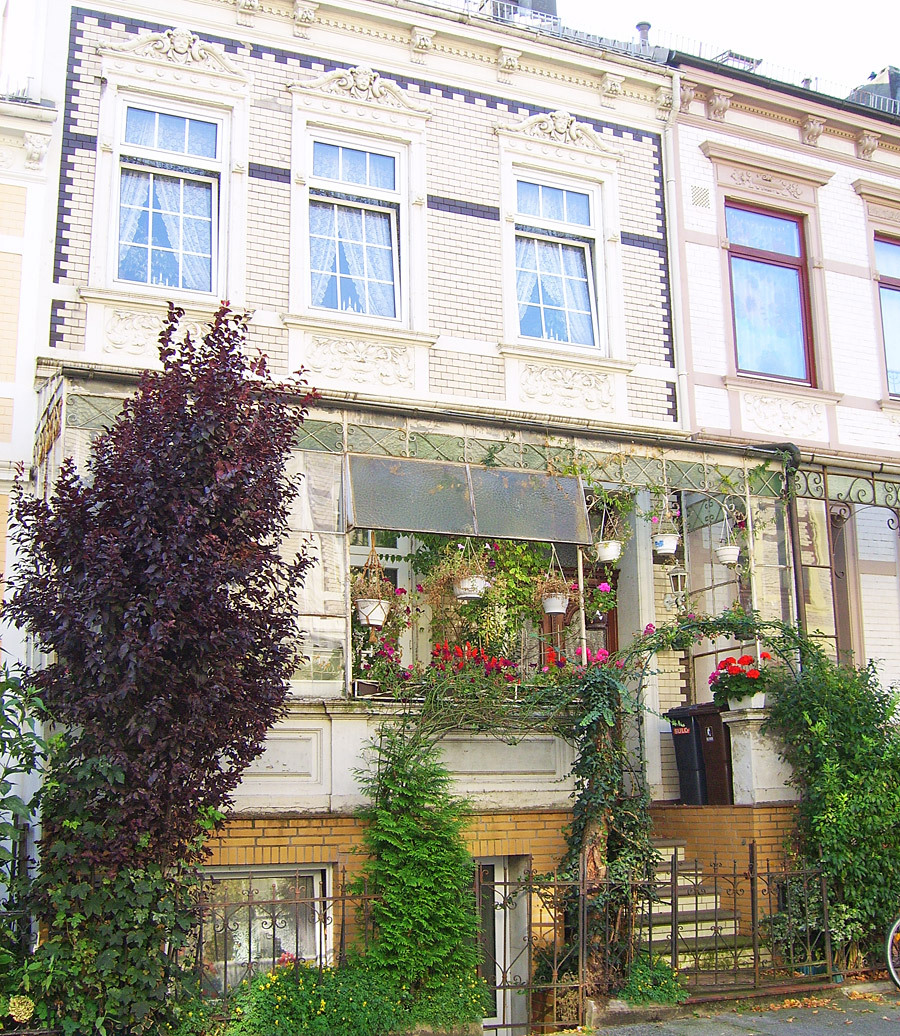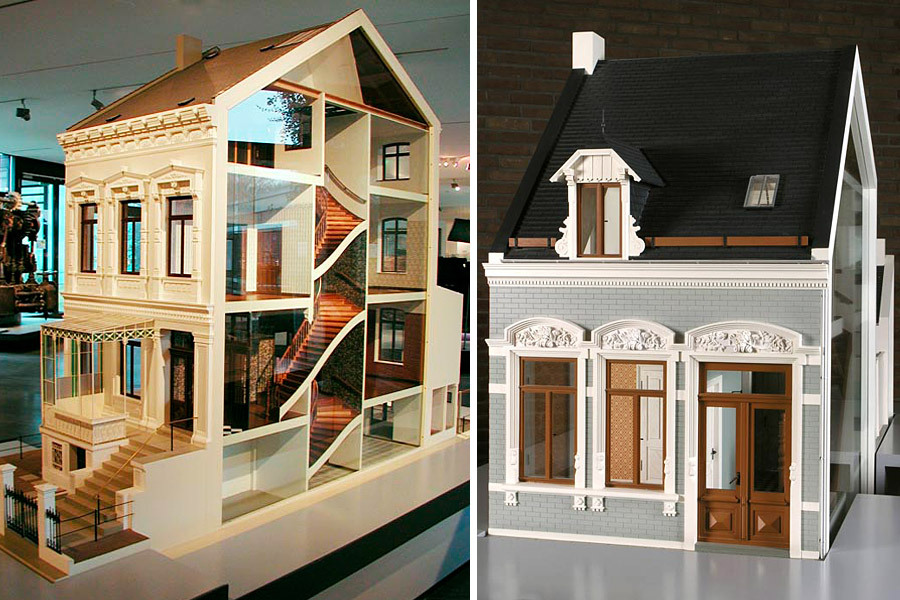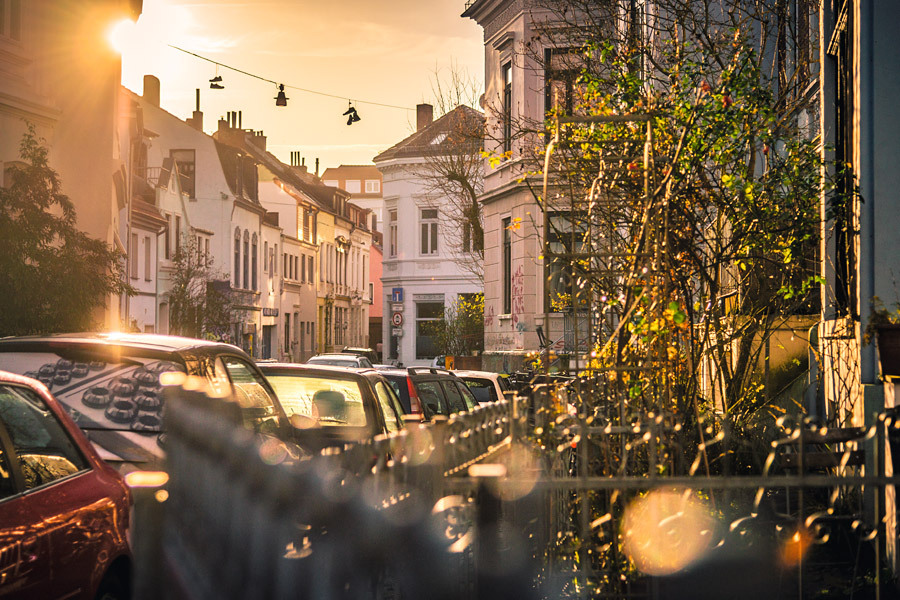Typical Bremen house – not so typical after all
Tourism
There’s something a bit different about the residential streets of Bremen, compared with other German cities. The streets of the outer districts are lined with terraced houses, which, although commonplace in Great Britain or the Netherlands, are quite unusual in Germany.
It all began in the middle of the 19th century: the industrial revolution meant cities were growing rapidly, which led to tenement houses being built in Berlin and Hamburg. In Bremen, the decision was made to prohibit this practice. Instead, terraced houses were built, designed as self-contained family homes.
Around the turn of the last century, the average Bremen house was home to just 7.6 people, compared with 23.3 in Hamburg, 40.7 in Breslau and a staggering 50 in Berlin. These statistics hardly changed until after the Second World War. Even so, almost half of all families in the state of Bremen owned their own home. This was a trend that developed during the 19th century, when many Bremen locals lived in large houses, surrounded by parks, such as on Marcusallee or in the Oberneuland district. This is alluded to in a saying that compares the ways of the three Hanseatic cities: “Lübeck drinks, Hamburg eats and Bremen lives above its station.”
Source: Bremer Lexikon, Werner Kloos und Reinhold Thiel, Verlag H.M. Hauschild GmbH, Bremen
The typical Bremen house, described by the city locals as Altbremer Haus (‘old Bremen house’), came in large versions for the wealthy merchants and captains, or in small form for the labourers and craftspeople. Though the size, the layout and the number of floors varied greatly, the construction was in principle always the same. Wikipedia (in German) offers detailed floor plans and drawings, but I will summarize some of the most important features here.

Style and construction of a Bremen house
The style of the houses developed over the years from classicist to historicist to art nouveau.
To protect against flooding, the street level is above the garden. Every house is positioned right on the edge of the street, with buildings on the far side of back courtyards prohibited. Because the homeowner had to pay for the street directly outside their house, the buildings are generally narrow and stretch out to the back. Originally, virtually every house would have had a front garden. As road traffic has increased, however, some streets have been widened and the gardens have had to be removed to make space.
Glass verandas were not introduced until later on; a veranda indicates that a house is a newer build, most of which are located far from the old quarter. There is usually a basement, which is partially below street level to the front. To the rear, however, the full height of the room looks out onto a garden or courtyard. There would have been an outdoor privy in the garden. In wealthier households, the basement would have been where the household staff lived and worked. The kitchen and utility rooms would originally have been down here, though many basements have nowadays been converted into entire apartments.
A set of steps leads up to the raised ground floor, which was entered via a vestibule. To one side, there are two large rooms, set one behind the other. To the other side was the staircase and behind it a smaller room that is often used as the kitchen these days. On the first floor, the layout is identical, with an extra little room in the position of the vestibule. In the attic, there would usually have been small rooms. Today, Bremen houses are often split up into two residences, with one household occupying the basement and ground floor, and the other the first floor and attic.
In the gardens and courtyards, you might find the occasional little shed, where households used to keep pigs or chickens. Happily, toilets are no longer in outhouses and are generally now found under the staircase.
This way of building meant that Bremen spread out horizontally, rather than vertically. This, I believe, gives rise to a high quality of life.
Many Bremen houses were damaged or destroyed in the Second World War, and the 1960s also wrought great damage. Stucco was deemed ugly, a preference emerged for plain exteriors, and cladding was attached to reduce heating costs. How was it the estate agent put it? “A weather-proof facade design.” A thin brickwork covering to you and me. And now, as a result of energy efficiency measures, the historical facades that survived that era are being destroyed by the installation of insulation. Hopefully we will see improvements in internal insulation solutions soon.
Many new homes are still built in the Bremen style. Of course, they look more modern and are described as ‘townhouses’ (even in German).

Bremen house models in the Focke Museum
In the Focke Museum, the Bremen Regional Museum for Art and Cultural History, you can see models of Bremen houses – one small and one large. The museum, which contains lots of other fascinating exhibits on Bremen architecture and more besides, is well worth a visit.


Bremen houses in the city districts
The best way to see authentic Bremen houses is to turn off the main boulevards and stroll around the residential districts of the city. Vegesack, Walle, Findorff … beautiful houses can be found in all the residential areas, though there are three districts that I find particularly interesting:
To see some really large Bremen houses, head to Schwachhausen. From the main train station, amble through the magnificent Barkhof quarter, and cross the busy Stern intersection to reach Wachmannstrasse. Some of the side streets off here feature some especially beautiful examples of the Bremen house style. Afterwards, why not wander back through the Bürgerpark?
Cultural monuments in Schwachhausenn (List in German)
There are also many beautiful examples of Bremen houses in the districts of Ostertor, Steintor and Peterswerder. In Ostertor in particular, it is easy to get lost in the side streets, so if you’re not familiar with the area, I’d recommend taking a map. On one side of Mittelstrasse, which leads off Ostertorsteinweg, you can see the rear view of Bremen houses; the ornate facades can be found on the parallel Mozartstrasse. Mathildenstrasse used to serve as a kind of real-life catalogue, demonstrating the different exterior design options that you could choose for your own house. There are some particularly pretty little streets around Hamburger Strasse.
Cultural monuments in Östliche Vorstadt (List in German)
There are also surviving examples of the traditional cigar-maker houses, mainly found in Neustadt, where a statue on Buntentorsteinweg pays homage to the old craft of cigar making. I had the chance to go inside one of these houses, which must have been very cramped and cold for the workers back then. These days, that house is home to many mechanics working closely side by side. To get a good sense of the contrast, I would recommend starting with the decorative exteriors on Gneisenaustrasse or Yorckstrasse. From there, carry on down Hardenbergstrasse right to the end and along Siebenrutenweg. Here, around Rosenpfad, you’ll find lots of the city’s smaller houses.
Tours for architecture enthusiasts
The Old town and Viertel explorer tour will also guide you down streets of old Bremen houses in Östliche Vorstadt. Take a look at our tour planner for more tips and suggestions.

Success Stories
Science plays a leading role in Bremen: in the laboratories of the university, at one of the more than 50 research institutes or in the green botanika. There are many opportunities for visitors to experience science at first hand.
Learn moreAccording to recent statistics, the Hanseatic city of Bremen is Germany's greenest big city, with 60 square metres of green space per inhabitant. The many parks and green spaces in the city include world-class spaces, such as the Bürgerpark and the Rhododendron park, both of which are of German and even world renown. By its own account, Bremen is home to the world's largest collection of rhododendrons. Let's take a walk.
Learn moreThe greenest major city in Germany is Bremen - with an average of 60 square metres of sports, leisure and recreation space per person. Parks, sports facilities, but also water areas invite you to relax from the hustle and bustle of the city every day.
Learn more